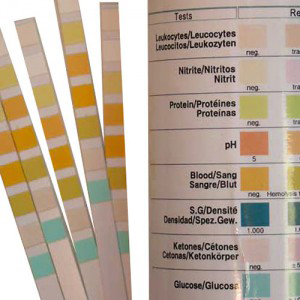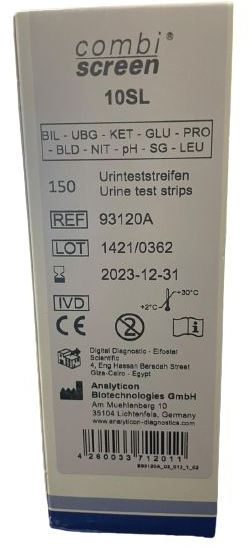URINE TEST, pH,bili,prot,gluc,ket,blood,nit,leuc, 1 strip
Valid Article
URINE TEST, pH, bili, prot, gluc, ket, blood, nit, leuc
CAUTION
This test is worded and codified by unit to make the order easier, but it is always packaged in kit of 50.
Definition
Test used for the determination of 8 parametres in urine: pH, bilirubin, proteins, glucose, ketones, blood, nitrites and leukocytes.
Specifications
Components
- Plastic box with colorimetric charts
- Silicagel sachet
- 50 strips for single use
Technical specifications
- Strip with 8 reagent pads which change colour according to the concentration of substances in urine.
- Parameters: pH, bilirunin, protein, glucose, ketone, blood, nitrite, leukocyte
- Colorimetric chart giving semi-quantitative results: -, ±, +, ++, +++, ++++ and mmol/L and mg/dl results.
- Sample type: urine
- Sample volume: few ml, enough to immerse the strip
Caution: Semi-quantitative result ranges may differ between different brands of tests.
Packaging & Labelling
Kit of 50 tests
Instructions for use
Follow the instructions in the leaflet.
Close the box tightly after each use since the test quickly deteriorates with humidity.
Please consult the “Updated laboratory procedures, 2022” available online via the Laboratory working Group sharepoint page: Laboratory Procedures and Resources.
https://msfintl.sharepoint.com/sites/msfintlcommunities/LabWG/SitePages/Laboratory-Manual-page.aspx
For offline access, contact your laboratory advisor.
- See: Updated laboratory procedures, MSF, 2022
- See: Essential Obstetric and New-born care, MSF, 2019
- See: WHO Model List of Essential In Vitro Diagnostics 2023
- See: Urine dipstick SSDTURIS8 SOP, MSF, 2021
- See: SSDTURI1S8 Urinary strip BA, MSF, 2022
- See: 14.10. SOP Urinanalysis dipstick
- See: MSF diagnostic packages, MSF, 2023
Storage
- Store between 2ºC and 30ºC, Protect from sunlight ‐ Protect from humidity
- Shelf life: 15 to 24 months
- Guaranteed minimum remaining shelf life at delivery: 1/3 of total shelf life
- Not to be used beyond expiry date
MSF requirements
These parameters allow the biological follow-up of urinary and genital tract infections, nephrotic syndroms and glucide metabolism problems.







![[KMEDMHLA11-] (mod hospital lab) RAPID DIAGN. TESTS + GLUCOMETER +HEMOCUE](/web/image/product.template/572569/image_256/%5BKMEDMHLA11-%5D%20%28mod%20hospital%20lab%29%20RAPID%20DIAGN.%20TESTS%20%2B%20GLUCOMETER%20%2BHEMOCUE?unique=270b93f)
![[KMEDMLAB15A] (laboratory module) BACT/HAEM/STOOLS/URINE REAGENTS](/web/image/product.template/573169/image_256/%5BKMEDMLAB15A%5D%20%28laboratory%20module%29%20BACT-HAEM-STOOLS-URINE%20REAGENTS?unique=7872303)
![[KMEDMHLA111] (mod hospital lab) RAPID DIAGNOSTIC TESTS](/web/image/product.template/572567/image_256/%5BKMEDMHLA111%5D%20%28mod%20hospital%20lab%29%20RAPID%20DIAGNOSTIC%20TESTS?unique=76debed)
![[KMEDMSUP05S] (IEHK 2024 suppl. module) SUPPLEMENTARY RENEWABLE UNIT](/web/image/product.template/583185/image_256/%5BKMEDMSUP05S%5D%20%28IEHK%202024%20suppl.%20module%29%20SUPPLEMENTARY%20RENEWABLE%20UNIT?unique=9fce31f)
![[ELABTIME1E-] TIMER, electronic](/web/image/product.template/571049/image_256/%5BELABTIME1E-%5D%20TIMER%2C%20electronic?unique=31469a1)
![[STSSCONT6U-] CONTAINER, SAMPLE, plast., 60ml, non sterile, urine](/web/image/product.template/570465/image_256/%5BSTSSCONT6U-%5D%20CONTAINER%2C%20SAMPLE%2C%20plast.%2C%2060ml%2C%20non%20sterile%2C%20urine?unique=8ec7222)